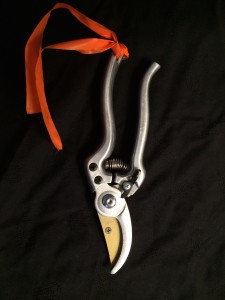Our gratitude to Paul Hetzler for this lovely piece, adapted for “Think IPM.” Here in one place is most everything you need to know about pruning to keep your trees fit and trim.
As far as trees are concerned, early spring is the best time to prune. (Late summer is second–best.) In the 4 to 6 weeks before bud-break, trees’ internal defense systems are perking up. It’s sort of the best of two worlds: Trees’ growth processes remain offline, but their shields are up against infection. (Like IPM says: give plants every opportunity to deal with pests the way they evolved to.)

Plus it’s a lot nicer working outdoors in early April than in January or February. OK, I guess that’s three worlds.
But first, a word about tools. Three kinds of tools. If you had to shovel your driveway with a spatula, you’d soon despair. Proper tools make a job easy. A professional-quality hand saw and bypass-type hand pruners are essential, and a good lopper is a welcome bonus. Good tools will last a lifetime, and you’ll be amazed at the difference they make.

Actually, many “threes” are involved in good pruning. For example, no more than a third of a tree’s live branches should be removed in any pruning cycle. (For older or stressed trees, however, 20% is maximum). But don’t remove a third of the leaf-bearing material each year. A typical pruning cycle for a shade tree is (surprise) three years.
Another guideline is that two-thirds of a tree’s leaf area should be in the lower half of the crown. In other words, don’t clean out interior foliage or remove lower branches unless there is a compelling reason to do so, such as safety or disease management. (It’s basic IPM — reach for the loppers before you reach for the spray.) Lower and interior branches are essential on hot sunny days when leaves in the upper canopy get above 85 degrees, which is too hot to photosynthesize. (IPM again: foster healthy plants that better resist pests.)
Get started with the three Ds: dead, damaged and diseased branches. (“Diseased” rings those IPM bells. Prevention!) They get the ax first. With those out of the way it’s easier to see what else needs attention. For crossing or rubbing branches, take the less desirable of the two. Whenever possible, favor wide branch-to-trunk attachments over narrow ones, which are more prone to breakage. (Broken branch-to-trunk? IPM again: prevent pathogens from finding an easy way in.)
In most cases, a branch is pruned back to the main trunk. But sometimes pruning back a large limb to a side branch is aesthetically preferable. Just be sure that side branch is at least one-third the diameter of the branch you remove.
Prune the branch, not the trunk. At the base of most branches you’ll see a swollen area — the branch collar. It produces fungicides. (Classic IPM biocontrol, only the tree takes charge) Branch collars also close wounds more rapidly than ordinary tissue. This is part of the trunk and should never be cut. To put it simply, flush cuts are bad.
For branches over an inch thick, use a 3-stage cut to eliminate or reduce tearing the bark. First, cut the underside of the branch about one-third of the way through, a foot from the trunk. Make cut #2 directly above the first to sever the limb. Holding the stub, make the third cut just outside the branch collar.

Obviously, maples bleed if cut in March or April. While research tells us the loss of sugars is not significant, you could prune maples in the 3rd week in July, which is the other good pruning window. For fruit trees that water-sprout excessively, late-summer pruning reduces this problem. Park your saw, though, during spring leaf-out and again in the fall before leaf drop—wounds made then can lead to serious long-term problems.
In the past, pruning cuts were painted with wound-dressing compounds, but research shows this can actually accelerate decay (an IPM no-no). As far as I know, people-wounds can still be covered up with Band-Aids. Good pruning tools are really sharp, so keep one on hand. Maybe you should bring three, just in case.
Find more of Paul Hetzler’s posts here: blogs.northcountrypublicradio.org/allin/author/paulhetzler/.